Explainer
- Explainer
- Space
The International Space Station was a model for peace. But Russia wants to leave. What’s going on off Earth?
Astronauts and cosmonauts work together on the ISS. But things have changed. Meanwhile, China has its own station. India wants one too. What are nations (and private operators) up to in space?
You’re on a leaking space station hundreds of kilometres from Earth. What do you do with your 24 minutes of remaining oxygen? Do you float as fast as you can to the escape capsule, or try and repair the leak?
This was the dilemma facing NASA’s Mike Foale and two Russian cosmonauts in 1997. They were on the Russian space station Mir, then the only station in orbit, and the worst space collision in history was unfolding. Moments earlier, an unmanned supply ship had slammed into Mir (“right where I slept actually,” says Foale, now retired), tearing a hole in its side and damaging its solar panels. As the station shook, sirens blared and Foale’s ears started popping. “For a moment, I thought, we’re dead, it’s torn us open. Because the aluminium [hull] is only three millimetres thick.”
Fortunately, the air leak was small: they had minutes, not seconds. Twenty-four minutes, according to the pressure gauge. Russian space rules decreed less than 30 minutes of oxygen meant abandon ship, so Foale prepared the escape shuttle. But the two cosmonauts didn’t join him.
Instead, the three-man crew would carry out a daring plan to save the station now spinning out of control. And it was Foale, the only American on board (at first suspected by the cosmonauts of being a spy) who came up with the winning move. The ageing Mir, which “smelt like a garage”, as Foale recalls, but thrummed with Russian disco music, would orbit Earth for another four years before at last being decommissioned.
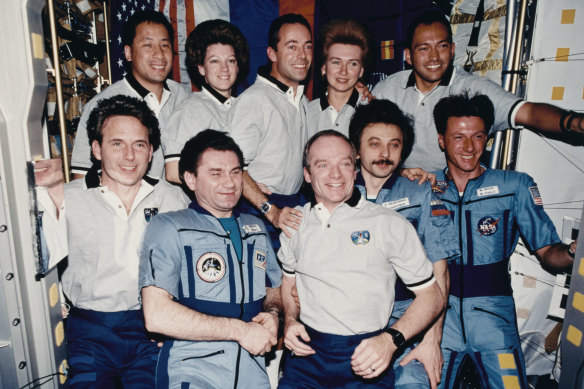
US and Russian crews including Mike Foale, front right, beside cosmonaut Alexander Lazutkin, and Russian commander Vasily Tsibliyev, front second from left.Credit: Getty Images
Today, Mir’s successor, the International Space Station (ISS), isn’t looking in great shape either. Every now and then, it springs a leak or gets clipped by space junk. China now has its own station and India has plans to launch one in the 2030s. Russia, after two historic decades of co-operation with the US on the ISS, had announced it would pull out of the station “after 2024”. Then in April, its space agency Roscosmos extended that until 2028, though head Yuri Borisov has stressed the need to build Russia its own station again.
Foale, a former commander of the ISS, says Putin’s invasion of Ukraine means the era of co-operation in space is ending. “We’re reverting back to the Cold War. It’s very painful.”
In fact, when the ISS is retired around the end of this decade, NASA won’t be replacing it at all. Privately run modules (including a space hotel) already under construction will take its place. NASA is funding a station around the moon instead.
So, why are countries racing to build stations again? And what’s it really like to live in space?
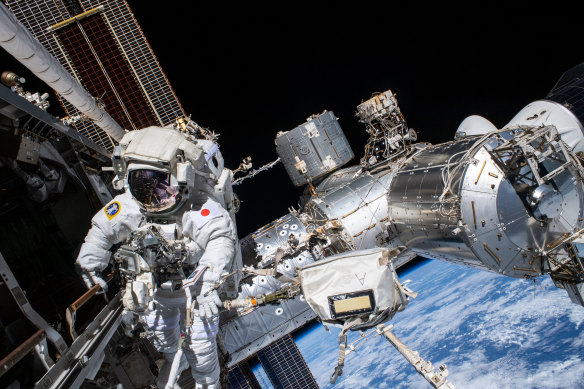
Japanese astronaut Koichi Wakata spacewalk outside the ISS in February.Credit: NASA
What’s a space station?
To the West Australian town of Esperance, it looked like an alien spaceship landing: a whirl of red and green lights streaking across the sky. This was NASA’s first space station, Skylab – a tangle of tech the size of a three-bedroom house. And it was about to crash.
When space stations are decommissioned, they tend to go out in a fiery blaze. Mir burnt up on re-entry above the South Pacific Ocean in 2001. Skylab was abandoned by NASA in the ’70s after less than a year, decaying on high until it broke into tiny pieces across the Indian Ocean and, most colourfully, above outback WA in 1979. (A local Australian council fined NASA for littering.) And the ISS – a $US150 billion feat of engineering run by 15 nations – will meet a similar fate when it retires in 2030, Foale sighs. That’s unless his campaign to see it preserved as a “museum piece” succeeds.
The ISS is the largest and longest-running of all the stations so far – an orbiting laboratory as long as a football field. Stations off-world let scientists test not only the effects of space on humans but breakthroughs not possible in Earth’s high gravity, such as 3D printing human organs, building artificial retinas to restore sight, and growing near-perfect protein crystals.
The ISS is made up of 16 linked modules – with additions such as Japan’s external “porch” lab and an inflatable habitat – but it’s largely divided into the Russian side, which controls the station’s engines, and the US side, which provides the solar power. Humans have lived there continuously since it launched in 2000, some for more than a year at a time. Astronauts and space tourists from 20 nations (although not Australia) have visited. Some experts even want it to win a Nobel Peace Prize. At night, you might glimpse the ISS whizzing overhead at 28,000 kilometres an hour, its huge solar wings spread as it orbits the earth once every 90 minutes.
‘It’s a wonder of the world. Even the pyramids don’t equal this.’
To Foale, there is no greater monument to human co-operation. “It’s a wonder of the world. Even the pyramids don’t equal this.”
But it’s also old, already years past its original 15-year lifespan. “Duct tape might be great for repairs in space, but things wear and tear,” says ANU astrophysicist Brad Tucker. The Russian side in particular is riddled with leaks and cracks. In 2020, cosmonauts managed to track down a tiny air leak only after they opened a tea bag and watched where the leaves floated. That same year, NASA had to send up a new $US23 million toilet. (“Boldly Go!” read the press release.)
Still, Foale argues the ISS could be preserved as a short-stay sightseeing centre at least, by pushing it not down to a fiery re-entry but up into a higher orbit where it’ll no longer need costly fuel to stay afloat.
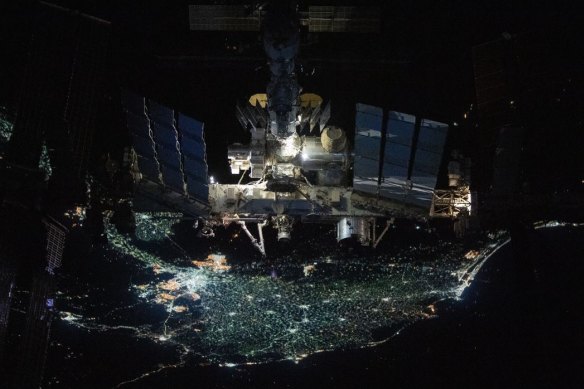
The ISS above Egypt’s Nile Delta in late 2021.Credit: NASA
Of course, as of late 2022, there’s another station in the skies. China’s new orbital Tiangong (meaning “heavenly palace”) has three astronauts on board, and the Chinese government already has plans to expand it. Its doors will open to both space tourists and foreign astronauts (provided they complete training in China) as it courts international research projects.
NASA is banned from collaborating with China by US Congress, a rule that has kept China out of the ISS (though Tucker, who has worked with NASA, notes data can still be shared with Chinese scientists). So far, the European Space Agency (ESA) has also ruled out sending astronauts to Tiangong, saying it has neither the budget nor “the political green light” to engage. But China’s “no limits” alliance with Russia already extends to space. They have plans to build a joint lunar base by the mid-2030s, for starters.
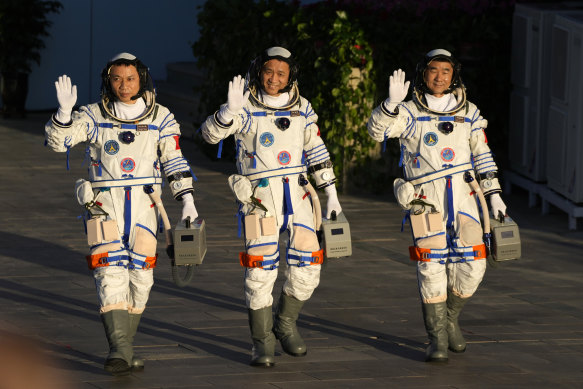
Chinese astronauts prepare to be the first on the nation’s new orbiting space station.Credit: AP
Tiangong, like much of China’s space tech, is built off old Soviet designs – experts call it essentially an upgraded version of Mir. Still, it has been praised for its “minimalist design” with fewer tangles of tech on board, even if the station itself is about a quarter the size of the ISS.
Tucker thinks China has now surpassed Russia as the other great space power outside the US. “They have the money and the willpower, and they don’t have to reinvent the wheel,” he says, likening China’s recent space push to the huge injection of funding that saw the US rocket past the Soviets to land on the moon in 1969. “Just look at how fast China assembled Tiangong. They beat their deadline by a month. No one does that – everyone’s late because space is so hard. So, when China says they’re going to the moon by 2030, they’re going to the moon by 2030.”
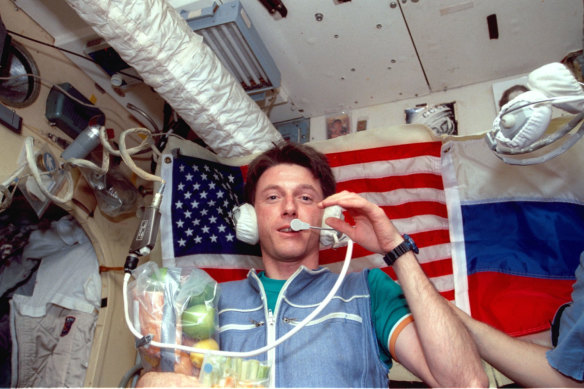
Michael Foale on the Mir station in 1999.Credit: Getty Images
Will Russia build its own station? What does India want?
The cosmonauts who lived with Foale on Mir might have suspected he was a spy “because [he] asked so many questions” but he soon became more than just the token NASA tag-along. Foale was also handy on a computer. After he wrote code to help improve his colleagues’ correspondence with Moscow, they asked mission control if Foale could handle all their communications. Moscow said no, at first. “I think probably they thought my Russian would be too poor. But I did it. I became like their Radar from MASH,” Foale laughs.
And so “Radar” was on hand during that disastrous collision of 1997. When his two cosmonaut colleagues opted to stay rather than flee the damaged Mir, Foale helped engineer Alexander Lazutkin seal the air leak. Then, after terrifying hours huddled in a station spinning in freefall without power, Foale held up his thumb to a window to measure Mir’s spin rate against the stars and hatched a plan: using the engines of their escape ship to realign Mir’s remaining solar panels with the sun and so restart its power. (Foale admits his “cunning” back-up strategy was to wait for his colleagues to pass out “and float them into the escape module”.)
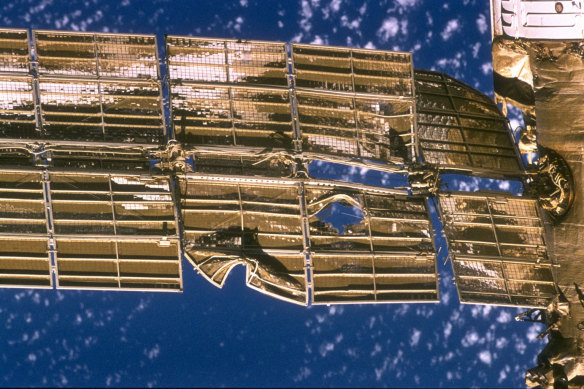
Damage to the solar array on Russia’s Mir space station after a Russian supply ship collided with it in 1997. Credit: NASA, Getty Images
Fortunately, Plan A worked. Then came the high-stakes repair job (“space walks to fix cables, and floating into dead, dark modules to suck up the jelly-like water accumulating without the power on, like going cave diving”). Today, Foale’s ties to cosmonauts still run deep but since Russia invaded Ukraine, he’s retired from his role on the international commission overseeing the ISS. He says the Russian side of the station is no longer tenable, even if Moscow turns out to be bluffing about its plans to withdraw before the ISS retires.
The Russians, after all, are the longest residents of space. They sent up the first satellite (Sputnik) in 1957 and the first human (Yuri Gagarin) four years later. As a new era of co-operation with the US saw NASA astronauts fly at their side, the Russians became the first to do space tourism too, renting Mir to a private firm for a time and later flying millionaires to the ISS. And, over a fortnight at the ISS in 2021, Russia became the first to film a movie in space (beating an upcoming project from Tom Cruise and Universal Pictures with NASA and Elon Musk’s SpaceX).
If Russia pulls out of the ISS early, experts say they could lose their foothold in space altogether. Roscosmos head Borisov has stressed the need for a Russian station. “Time is running fast and we cannot take a break from manned spaceflight under any circumstances,” he told President Vladimir Putin in a televised meeting in April.
“But no one really believes Russia has the budget to build its own station again,” says Tucker. “Russia is slipping. They could even slip below India before too long.”
After NASA retired its shuttle program, ferrying astronauts into space became a “huge cash cow” for Russia, he says. But now it is SpaceX flying NASA astronauts – on a new generation of lighter, reusable (and so cheaper) rockets. And with Russia’s wartime economy stretched, the focus of Roscosmos has also shifted from research to military – putting more satellites into orbit to help Russian troops spy in Ukraine, for example.
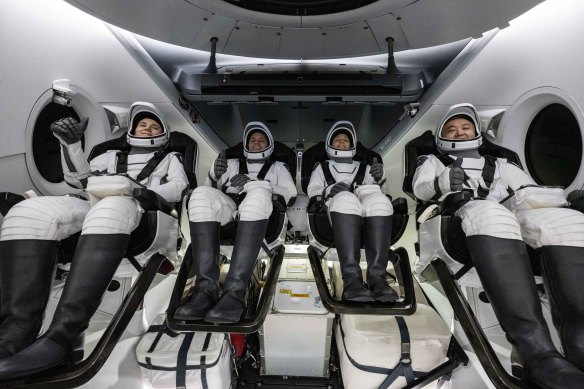
Roscosmos’s Anna Kikina, NASA’s Josh Cassada and Nicole Mann and Japan Aerospace Exploration Agency’s Koichi Wakata in a SpaceX craft after having landed in the Gulf of Mexico on March 11.Credit: NASA
Even on the ISS, long praised for rising (or floating) above earthly conflicts, Russian cosmonauts have been rebuked for celebrating Russian victories in Ukraine. And there was the sensational threat by previous Roscosmos head Dmitry Rogozin, who claimed US sanctions targeting Russia’s space program would send the ISS tumbling to the ground over the US or Europe.
On a practical level, disconnecting the Russian side of the ISS early would be no small task. “It’ll take a lot of space walks,” says Foale who, as a dual British and American citizen, is also the first Brit to walk in space. Crucially, the Russian engines keep the station at the right altitude. “But the US has been testing if they can use [the thrust of] ships docking there as an orbit boost instead,” says Tucker. He says Russia may start building modules for the Chinese station instead of the ISS soon. “Russia has the expertise and the history that China needs.”
‘Countries can do this now, on their own. I think we’ll see two alliances.’
India, meanwhile, has emerged as another serious space power, gearing up to send its first astronauts solo into space in coming years, although launching its own national station has been delayed to the mid-2030s (and details of all India’s missions are scant).
Stations orbiting the Earth are now proven technology, Tucker says – they will start to move beyond just science into other uses too, from tourism and manufacturing to defence. “But I think there’ll be less co-operation. Countries can do this now, on their own. I think we’ll likely see two alliances: China and Russia, and then a [Western] one.”
India, for its part, has longstanding ties to the Russian space program, which helped it develop cryogenic engine technology (despite interventions from the US). Yet it’s also been forging research collaborations with countries such as Australia and France.
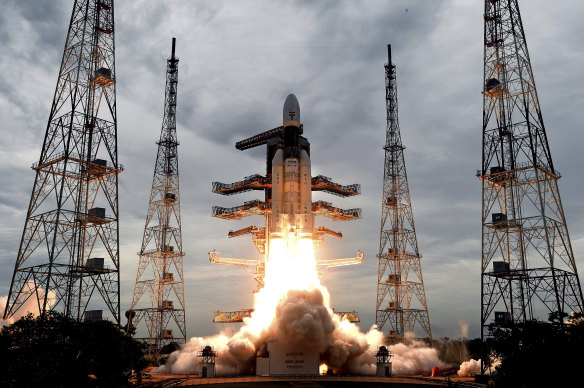
India launches its unmanned moon orbiter Chandranyaan-2 in 2019.Credit: ISRO
Who else wants a space station?
Plush walls, like a casino lounge, dotted with coloured lights. Large windows for the best views of Earth, and crew quarters that feel like a safe nest, “a friendly egg”. So reads the design brief from private firm Axiom Space for the ISS replacement modules it’s now building. They will start to go up and attach to the station as early as 2025, and eventually replace it outright. Axiom (headed by NASA’s former ISS manager Mike Suffredini) says it can build the next-generation station for a fraction of the cost of the original, closer to $US3 billion. And NASA estimates it’ll save $US1.8 billion a year by retiring the ISS and instead leasing space on private stations.
It’s also backing plans headed by Jeff Bezos’ Blue Origin to build the Orbital Reef station by the end of the decade, along with the Starlab “science park” by Lockheed Martin and others, aiming to launch in 2028.
‘To put something up on the old shuttle cost about $US50,000 a kilogram. Nowadays, you’re sitting around $US2000.’
Priorities have shifted, says Foale, previously deputy head of exploration at NASA. The agency plans to return humans to the moon by 2025 and land a crew on Mars in the 2030s, and other nations are hot on their heels. “So the ISS is a pretty big bill to keep paying,” he says.
Private stations mean “NASA can have its cake and eat it too”, Tucker agrees, focusing funding on a proposed lunar station instead. “That’ll let us do all the science we’ve done around the Earth around the moon. Another leap forward.”
The emergence of the private sector has revolutionised space access and turbocharged research, he says. “To put something up on the old shuttle cost about $US50,000 a kilogram. Nowadays, you’re sitting around $US2000 and that price is still falling.” In 2014, India famously spent just $US100 million, less than the budget of the space film Gravity, to send an unmanned orbiter all the way to Mars.
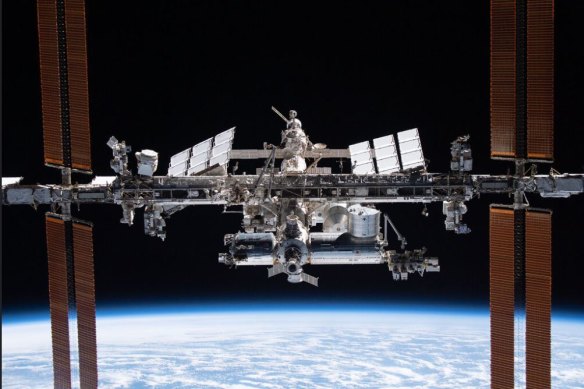
The ISS above the Earth in 2021. Credit: NASA
Competition is good for space, says Foale, who sometimes consults for commercial space firms via his company Foale Aerospace.
But the stakes are high. In that cold vacuum, the margin for error is frighteningly thin. The health impacts of space on fit astronauts are still being understood – from a heightened risk of cancer and clots to bone density and cardiovascular issues, sometimes even unexplained blindness. And that’s before you get to ageing space tourists going up, says Tucker.
Many experts warn laws must catch up to this emerging commercial space age – to avoid a repeat of the chaotic early days of aviation. Others say too much regulation too soon will stifle innovation. Tucker thinks Australia could yet play a bigger role as a “second tier” space nation, not running missions but helping out, and keeping checks on the big players. (In April, Australian Katherine Bennell-Pegg started astronaut training with the ESA.)
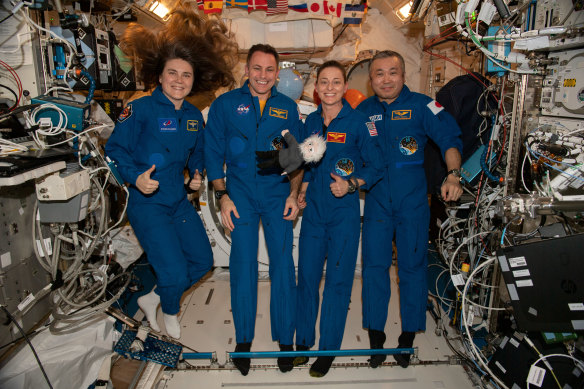
From left, ISS flight engineers from Roscosmos, NASA and Japan’s Aerospace Exploration Agency before their return to Earth in March.Credit: NASA
So, what’s it like to live on a space station?
On his last trip from the ISS, a cosmonaut friend congratulated Foale. “‘You’ve now spent a year in space,’ he told me. I said, ‘Really?’ See, the Russians care. They keep statistics.”
The ISS is a few stars up from the accommodation on Mir, he laughs, where modules were so crammed with wires that hatches couldn’t close, and soot stained the windows from previous onboard fires. But the music selection – at least, on his first stay at the ISS – fell short. “They had, like, 12 CDs!” Soon, though, DJ Foale had mixed a playlist thanks to a laptop left behind by a space-tourist friend. “There was Kylie Minogue. And I put some Russian disco music in too [for] old times.”
The ISS keeps Greenwich mean time, although it sees 16 sunrises and sunsets each day. It hums with many languages. Each country has its own food allowances, so meals are eagerly traded among astronauts. In the weightlessness of microgravity, the blood rushes to your head, leaving your eyes puffy and nose blocked. “You can’t taste as well,” explains Foale. “So a lot of people love spicy foods. I took lots of chocolate and – oh, this sounds disgusting – dried Russian cottage cheese. With nuts!”
‘What’s harder is training people to follow orders up there.’
Astronauts speak of “the big moment” – seeing the Earth from space – with a special reverence. On Foale’s first trip, roaring up through the atmosphere, an ash cloud from a Philippines volcano washed the skies out to grey. “So that was a letdown,” he chuckles. But soon the view widened, he says, and it was “everything I’d imagined. You see Africa, its fantastic reds and oranges. Greenland, all the fjords people love to draw. Even Australia. People say Australia’s this boring red landmass. I think it’s beautiful.”
On station, it’s never quite dark with the glow of our blue planet below. Sleeping bags are tethered to walls. (“It’s very comfortable, falling asleep and falling around the world,” says Foale.) But water is so costly to get into space, it’s strictly rationed. That means no showers; astronauts use wet towels and rinseless soap to stay clean.
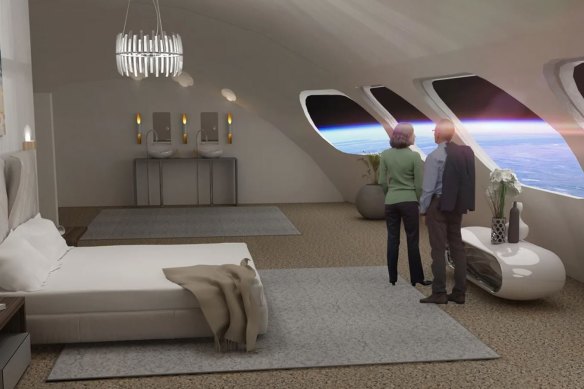
A mock-up of a proposed luxe space hotel, Voyager Station, promising to simulate one-sixth of Earth’s gravity for a comfortable stay. Credit: Orbital Assembly
Though more of us on Earth will soon be getting our “space legs”, what training will be required remains a live question. On short space flights at least, Tucker says boarding requirements so far seem to stop at “holding your bladder for two hours”.
Foale, a “physicist not a military man”, likens his own rigorous training with NASA (and in Russia before he boarded Mir) to learning to scuba dive. He doesn’t think it’s “as formidable as the autobiographies make out”, though astronauts do train in extreme conditions, desert heat, and freezing cold. “Yes, wearing an oxygen mask in a jet … and the big rubbery suit is uncomfortable, especially if it’s summer in Houston. But after a while – if you’re wearing comfortable underwear – you get used to it. What’s harder is training people to follow orders up there.”
On Mir, cosmonauts had a gun “to keep away wolves”, in case they landed in the remote wilds of Siberia. Today, Foale says, astronauts don’t carry weapons. He helped draft the ISS’s official code of conduct that all visitors and crew sign. “It’s like maritime law, the commander has authority. But not everything is forbidden. Sex, say, isn’t forbidden.”
He expects private stations may run in a similar way. “Think of what you sign when you stay at a hotel: ‘I won’t smoke in my room’. But some stations might allow more than others. It’s like, do you go to Las Vegas or some [puritan] community in New England?”
Still, he does offer this advice: “If you ever fly in space, just make sure you have a scientist with you.”
Fascinating answers to perplexing questions delivered to your inbox every week. Sign up to get our Explainer newsletter here.
Let us explain
If you'd like some expert background on an issue or a news event, drop us a line at explainers@smh.com.au or explainers@theage.com.au. Read more explainers here.